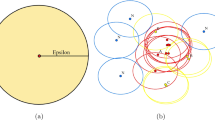Abstract
One of the most important issues in the field of engineering seismology is identification and classification of seismic provinces. Due to the importance of this issue in Iran, various studies have been conducted using different methods such as expert judgment, computational methods, data-driven methods, and smart methods. The purpose of the present research is to develop a spatio-temporal seismic model for Iran using robust and objective clustering tools. In the present study, one of the most powerful clustering methods, DBSCAN, is selected based on its ability to analyze huge amounts of data. The DBSCAN algorithm, which acts based on the density of seismic events, is capable of detecting arbitrarily shaped clusters. The seismic datasets used in this study, which were obtained from the seismic catalog of Iran from 1900 to 2015, have been divided into three window periods including 2- , 5- , and 10-year intervals. Afterward, different seismicity patterns for each period are obtained by applying DBSCAN algorithm. Then, those exhibited high agreements in terms of shapes and locations of clusters with the other models are determined. Ultimately, by considering these models and using expert judgments, a unified spatio-temporal model is presented. The results reveal meaningful information in different parts of Iran especially in Zagros, Alborz, and Azerbaijan zones and are generally in good agreement with previous studies. Moreover, the results emphasize that a seismic model, which is obtained based on considering seismogenic zones in various time periods along with the application of density-based clustering tools, will produce reliable results.
















Similar content being viewed by others
References
Ansari, A., Noorzad, A., & Zafarani, H. (2009). Clustering analysis of the seismic catalog of Iran. Computers & Geosciences, 35(3), 475–486. doi:10.1016/j.cageo.2008.01.010.
Berberian, M. (1976). Contribution to the seismotectonics of Iran (part II–III): in commemoration of the 50th anniversary of the Pahlavi dynasty. Ministry of Industry and Mines, Geological Survey of Iran, Tectonic and Seismotectonic Section.
Berberian, A. (1979). Discussion of the paper A. A. Nowroozi, 1976 “Seismotectonic provinces of Iran”. Bulletin of the Seismological Society of America, 69(1), 293–297.
Ester, M., Kriegel, H.-P., Sander, J., & Xu, X. (1996). A density-based algorithm for discovering clusters in large spatial databases with noise. In KDD 1996 (Vol. 96, pp. 226–231, Vol. 34).
Han, J., Kamber, M., & Pei, J. (2012). Data mining: Concepts and techniques. In J. H. Kamber & J. Pei (Eds.), Data mining (3rd ed., pp. 1–38). Boston: Morgan Kaufmann.
Hartigan, J. A., & Wong, M. A. (1979). Algorithm AS 136: A k-means clustering algorithm. Journal of the Royal Statistical Society: Series C (Applied Statistics), 28(1), 100–108.
I. N. C. o. L. D. (IRCOLD). (1996). Seismotectonic province of Iran (p. 50).
Jain, A. K. (2010). Data clustering: 50 years beyond K-means. Pattern Recognition Letters, 31(8), 651–666. doi:10.1016/j.patrec.2009.09.011.
Mirzaei, N., Gao, M., & Chen, Y.-T. (1999). Delineation of potential seismic sources for seismic zoning of Iran. Journal of Seismology, 3(1), 17–30. doi:10.1023/a:1009737719013.
Mojarab, M., Memarian, H., Zare, M., Hossein Morshedy, A., & Hossein Pishahang, M. (2014). Modeling of the seismotectonic provinces of Iran using the self-organizing map algorithm. Computers & Geosciences, 67, 150–162. doi:10.1016/j.cageo.2013.12.007.
Nowroozi, A. A. (1976). Seismotectonic provinces of Iran. Bulletin of the Seismological Society of America, 66(4), 1249–1276.
Peng, L., Dong, Z., & Naijun, W. (2007). VDBSCAN: Varied density based spatial clustering of applications with noise. In service 2007 International conference on systems and service management (pp. 1–4), June, 9–11 2007. doi:10.1109/ICSSSM.2007.4280175.
Shahvar, M. P., Zare, M., & Castellaro, S. (2013). A unified seismic catalog for the Iranian Plateau (1900–2011). Seismological Research Letters, 84(2), 233–249. doi:10.1785/0220120144.
Ward, J. H. (1963). Hierarchical grouping to optimize an objective function. Journal of the American Statistical Association, 58(301), 236–244. doi:10.1080/01621459.1963.10500845.
Weatherill, G., & Burton, P. W. (2009). Delineation of shallow seismic source zones using K-means cluster analysis, with application to the Aegean region. Geophysical Journal International, 176(2), 565–588. doi:10.1111/j.1365-246X.2008.03997.x.
Xu, R., & Wunsch, D. (2005). Survey of clustering algorithms. IEEE Transactions on Neural Networks, 16(3), 645–678.
Zamani, A., & Hashemi, N. (2000). A comparison between seismicity, topographic relief, and gravity anomalies of the Iranian Plateau. Tectonophysics, 327(1–2), 25–36. doi:10.1016/S0040-1951(00)00160-8.
Zamani, A., & Hashemi, N. (2004). Computer-based self-organized tectonic zoning: A tentative pattern recognition for Iran. Computers & Geosciences, 30(7), 705–718. doi:10.1016/j.cageo.2004.04.002.
Zamani, A., Nedaei, M., & Boostani, R. (2009). Tectonic zoning of Iran based on selforganizing map. Journal of Applied Sciences, 9, 4099–4114.
Author information
Authors and Affiliations
Corresponding author
Electronic supplementary material
Below is the link to the electronic supplementary material.
Rights and permissions
About this article
Cite this article
Kazemi-Beydokhti, M., Ali Abbaspour, R. & Mojarab, M. Spatio-Temporal Modeling of Seismic Provinces of Iran Using DBSCAN Algorithm. Pure Appl. Geophys. 174, 1937–1952 (2017). https://doi.org/10.1007/s00024-017-1507-0
Received:
Revised:
Accepted:
Published:
Issue Date:
DOI: https://doi.org/10.1007/s00024-017-1507-0




